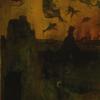
Posted
I have discovered the YouTube Channel and Music School Improvise for Real recently.
They teach a concept called melody path. It helps to improvise over a chord progression.
I would like to implement it using Synfire. Iam a beginner of Synfire and need a bit help from senior experts. I am overwhealmed by vertical, horizontal, chord and other types of symbols.
Please....
Would you kindly spend some time to watch the video and tell me which symbols should be used to mimic the concept.
Thanks a lot.
Wed, 2022-05-11 - 20:15 Permalink
It s playing a I(tonic)-IV(subdominant)-V(dominant)-I(tonic) chord progression in a certain to choose key : e.g Cmajor , Dminor , etc
Seems 4 note chords and using those notes to play over the progression as a melody
Following the shortest distance between the successive notes to play
If you make such a melody map , then you know what melodynotes to play when the chord progression is running
Start with Cmajor key : look at your keyboard with the ladder own chords
Easy to do with a palette to make the chordprogression, but when doing more with chords you memorize the chordtype
Wed, 2022-05-11 - 20:22 Permalink
Thx @janamdo, maybe my question was unclear. I know the editing of the chords / harmony part/context in Synfire. My question was more which symbols to use to mimic the melodic part of melody path concept using Synfires symbols on the basis of harmonic context.
Wed, 2022-05-11 - 20:22 Permalink
Thx @janamdo, maybe my question was unclear. I know the editing of the chords / harmony part/context in Synfire. My question was more which symbols to use to mimic the melodic part of melody path concept using Synfires symbols on the basis of harmonic context.
Wed, 2022-05-11 - 21:01 Permalink
Drag and drop harmony parameter onto the figure parameterslot in order to get those chords on a instrument
Adding a second instrument for improvising with the notes in front of you to choose from.
All improvised melodies are chord notes: it sounds always good.
New ( i just realize) is the overview page were you can see the rendered midi output: if you look at the chordprogression you can see the voice leading
Note: i noticed when looking at the chordprogression that the first chord is not repeated in the the 5 th bar ..
This overview page could beh andy for improvising if it should show the note values?
Wed, 2022-05-11 - 21:07 Permalink
Thx @janamdo, but back to my question.
Again, @janamdo I seem not capable to explain what I am after.
Let me try again:
In the video the instructors play a note say 2 in melody path.
My question is: What symbol type is the equivalent in Synfire 2 Horizontal, Vertical, chord/arpeggio ....?
My hunch is its chord / arpeggio (w/o chord inversion).
Can somebody confirm it ?
Wed, 2022-05-11 - 21:08 Permalink
> which symbols to use
You probably already saw this, but a brief overview of the different symbols is provided here. This may initially all sound a bit overcomplicated, but in a nutshell you are helping Synfire to make decisions on which exact pitches to choose with this additional information.
For creating a melody, just start with horizontal (blue) symbols. By contrast, for the accompaniment you want to start with the chord symbols, and the bass symbols kind of explain themselves.
Later, when you want to further fine-tune your results you might consider using the vertical symbols for your melody. In a nutshell, these implement the notion stemming from modal jazz that certain scales "work" above certain chords, so the scale used changes more frequently with vertical symbols. By contrast, the scale is more static when using horizontal symbols. The relative symbols are a variant of the vertical symbols, also useful for melodies that implements a dynamic offset of the "rugs" depending on the current chord.
Hope this helps.
Thu, 2022-05-12 - 08:41 Permalink
Well, I think the confusion arises because you expect it to be more complicated than it is. In fact, the first video simply demonstrates a I-IV-V-I progression and its chord tones.
Use horizontal or vertical symbols to replicate this. Use bass symbols for bass voices.
Just focus on the relative movement you want a melody to have. Synfire does the "melody paths" automatically.
Thu, 2022-05-12 - 19:13 Permalink
Hi!
I try to do something similar that the things done in the video Melody Path with Synfire. I choose Orchestral Harmonic in Interpretation Tab and nearly got the chords tone similar the video except the maj7 I got the b7.
Is it possible to have maj7 in the scale?
Thu, 2022-05-12 - 20:01 Permalink
> is it possible to have maj7 in the scale?
Depends on choosen key if the desired chord belongs to this key
Chords and keys, how do they belong together (popschoolmaastricht.nl)
Thu, 2022-05-12 - 21:10 Permalink
You can make stricter settings for Interpretation to allow only chord tones:
(https://docs.cognitone.com/synfire/EN/interface/InspectInterpretation.h…)



